- This article gives a comprehensive
summary of the steps involved in a wedding of the Namboodiri community of
Kerala. Pictures make you visualize the ceremony as it happens.
Marriage marks the beginning of a
partnership between man and woman. This partnership as per the Vedic type of
marriage is for offering services to the entire world, in general and Gods, Pitrus (ancestors), humans and cohabitants, in particular. It also
denotes an extremely sacred [paripaavanam]
coexistence with equality and mutual understanding to acquire progenies of
superior quality, good health, wealth and capable of performing their duties.
Marriage rituals are performed after seeking the blessings and permission of
Gods and ancestors, keeping these objectives in mind. The preparation also
includes rituals for physical and mental
purification.
Engagement or “Veli Nischaya” marks the beginning of the process when the elders of the couple meet and announce their formal agreement for the marriage. Matching of the horoscopes of bride and groom is a pre-requisite for marriage. Fixing auspicious time and the date of marriage is also part of this ceremony.
The marriage ritual itself is quite extensive and spread over a 4-day period with the couple performing rituals and ‘homas’ in the mornings and evenings following the main marriage ritual conducted on the first day. Here we take a brief look at the main marriage ritual performed on the first day.
Two additional ceremonies
forming part of Namboodiri weddings need special mention.
First is called “Ayniyoonu” which is generally held on the day before marriage. This ritual involves the bride and groom having a ritual lunch in their respective houses at the same auspicious time, after seeking the blessings of elders. The groom along with the party then formally sets out to the bride’s home for the marriage. In earlier days, marriage ceremony was conducted at the bride’s house.
The second is “Kutiveppu”, formal entry of the newlyweds into the groom’s residence. A ceremonial welcome awaits them where the rituals are performed with the couple seated in “Nadumitttam”, the central courtyard. The senior most lady of the house performs Pujas after which all the ladies feed them milk and banana. This is followed by song and dance by the ladies to celebrate the new arrival.
‘Smritis’ enunciate eight types of marriages - namely Braahma, Prajapatya,
Arsha, Daiva, Gandharva, Asura, Rakshasa and Paishacha.
The marriage of Kerala brahmins, called “Veli”, is a Vedic ritual, a combination of three Sattvic types: Braahma, Prajapatya and Daiva. The rituals and mantras vary among the followers of Rigveda, Yajurveda and Samaveda as also between Ashvalayanas and Kaushitakas among Rigvedis. The basic sequence and individual steps are more or less identical among all sects.
This write up does not cover the
marriage ritual followed by individual sects but gives an overview of the
Ashvalayana marriage ceremony.
Ashvalayana marriage
Ashvalayana marriage has many specific
individual steps which are briefly presented here in the same sequence in which
these are prescribed along with the significance of each step. Note that steps
1 to 13 are preparatory rituals for the main ritual that follows.
1. Varanam - As the first step, bride’s father invites the groom and requests him to perform the marriage ceremony after taking a ritual bath. He does this and comes specially dressed (“Thattutukal”) for the function.
Donation to deities – This is done at the base of lighted lamp to seek blessings of family, village and other worshipped deities.
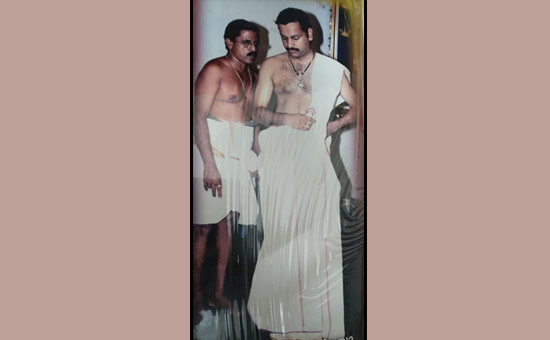
2. Offering to Ganapati - Like all rituals, marriage ceremony also commences with “Ganapati Nivedyam” seeking Vighneshvara’s blessings for removal of obstacles.
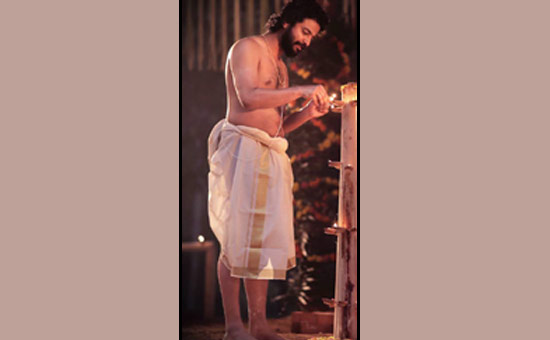
3. Donations
seeking pardons (Prayaschitta daanam)
- A series of ritual offerings seeking pardon for any errors, which might have happened
in earlier Brahminic rituals as well as any mistakes in prescribed daily
rituals, bad deeds committed so far knowingly or unknowingly, etc.
4. Nandeemukham - Ritual donations seeking the
blessings and permission of Gods and ancestors offered to representative
Brahmins.
5. Purification
(Punyaham) - Ritual purification by spraying of water with chanting of ‘Punyaha’ mantras. Water from Ganges, symbolically brought forth (Avahana) into a vessel containing Sattvic items and purified with
mantras is used in this ritual to get rid of impurities, seek divine blessings,
longevity, good health and prosperity.
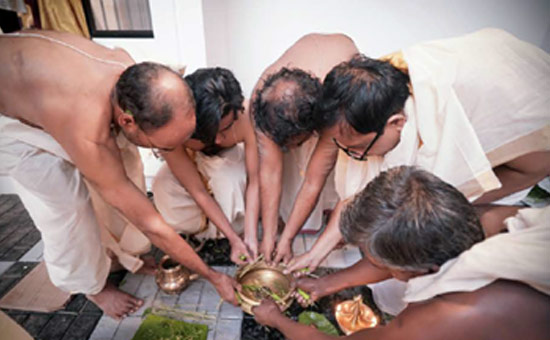
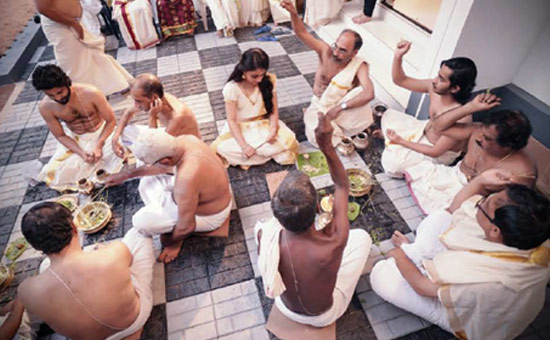
Note that items 2 to 5 are to be done separately for the bride and the groom; bride’s father will perform the rituals on the bride’s side.
6. Special
purification ritual for the bridegroom - A lady stands in front of the
bridegroom holding a pot filled with rice, decorative flower bunch (Tengin pookkula or the tender flowers of the coconut tree) with lighted wicks
placed on a bare coconut. The ritual involves waving of the pot with the wicks
aflame, in circular motion in front of the bridegroom to get rid of any
negative energy or vibrations.
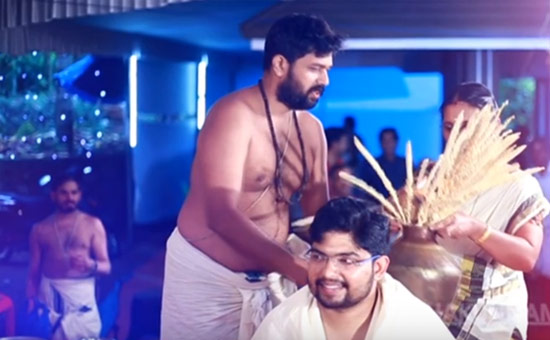
7. Ritual
welcome of the groom - Bride’s father formally bows (does Abhivadyam) and ritually washes the groom’s feet.
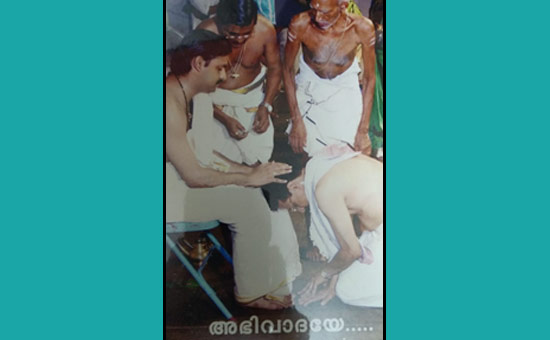
8.
Provision of new dress by bride to groom and by
groom to bride. They then change into these new clothes to perform the main
ritual.
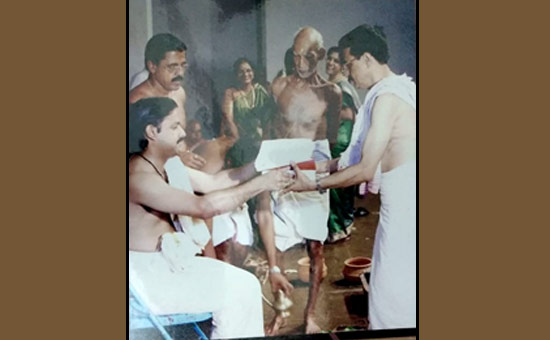
9. Tying of bride’s Kantha sutram (Tali kettal) - A pious thread, similar to ‘Upaveetam’, ritually prepared reciting mantras is used for this along with ‘Thali’, a very important small gold ornament. The bride’s father seeks blessings by doing Pooja to Shiva and Parvati and then ties it around the bride’s throat at the auspicious time, Muhurtam. With this important step, she is eligible to perform Vedic rituals.
“Smruthi suggests two types of thaalikkettu. Either the bride's father or alternatively, the bridegroom, may do it. Namboothiris opted for the former. The former enables the wife to perform the Bali, and Sraadham of her own father mother and husband and also to perform "Nedikkal" (simple oblations performed at home), unlike in the latter case. Tamil Brahman women, for example, need their husbands to perform rites and rituals. Out of the eight different marriage styles for Indian Brahmanans, the only style which needs the bride's father to do Thaalikettu was opted by Namboothiris. It is called Kantthasoothram. All the other four are
called Mangalyasoothram which need husband to do Thaalikettu. For ladies, Kantthasoothram is better as it enables them to perform the above said rites and rituals of her own parents, without help from her husband.” Source here
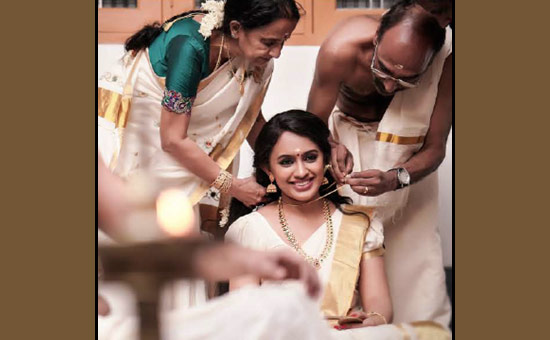
This Thali is a very important part of
her life now, which she has to wear till her husband is alive. (Tying of Kantha
sutram by father is a special feature of Vedic Kerala Brahmin marriage, with
which she becomes eligible to perform Vedic rituals).
10. Preparation
of puffed rice and eye liner - Bride gets these ready. Puffed rice required for ‘Laja homa’ and eye liner to be applied by the groom are ritually prepared by the bride.
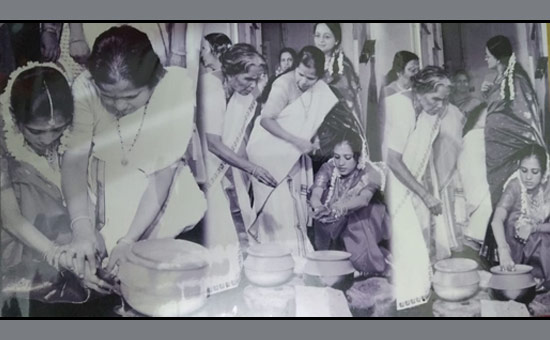
11. Start of
Homa, fire ritual - The groom in new traditional attire, initiates ‘homa’, an important part of the marriage ritual. After preparation and purification of sacrificial offerings and implements used, he waits for the bride’s arrival.
12. Waving of
1000 wicks (Ayirathiri Uzhiyal) - As the bride arrives, a lady waves at her with a plate laden 1000 wicks, which are lit aflame. This ritual denotes a grateful send-off to ‘Vishavasu’, the Gandharva who has been the girl’s ever-present protector till marriage. These 1000 wicks are prepared by the bride and her relatives (young girls and married women) on the previous day of the marriage which is called “Ayniyoonu” described briefly in para 3 of this write up.
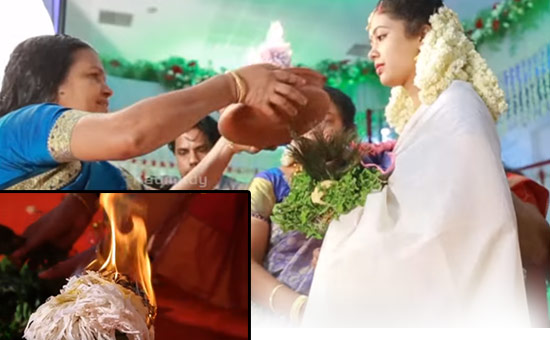
13. Seeing each other’s faces (Mukha darshanam) - Groom now does a ‘danam’, ritual donation, seeking divine blessings and permission to see the bride’s face. They now look at each other’s faces. Bride drops a garland of Tulasi into the groom’s hands for him to wear during the ceremony.
14. Udakapurvam - This is an important ritual in which bride’s father reciting the mantra, “Saha
dharmam charata…”, pours water from the ritual vessel into both hands of the bride who then pours it into the groom’s hands held below hers. This ritual and the mantra chanted during the ritual, signifies instructions for the couple to henceforth perform all Dharmic rituals and domestic duties jointly. Accordingly, the bride formally joins the groom in the rituals that follow.
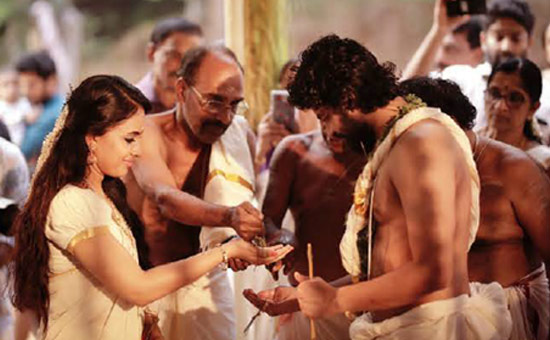
15. Holding
hands, Panigrahanam - Another very important ritual is where the groom formally holds the bride’s hand, reciting special mantras. Through these mantras, the couple vows to live together and perform Dharmic rituals and domestic duties jointly till death.
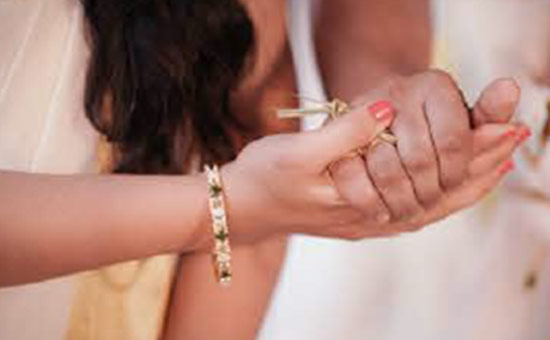
16. Offering of
puffed rice, Laja homa - Now the groom makes the bride perform
sacrificial offering, Laja homam to Aryama, the God of marriage in which a
mantra is recited by the groom. Vedic scholars now start chanting of Vivaha Sukta
(Veliothu) to bless the couple.
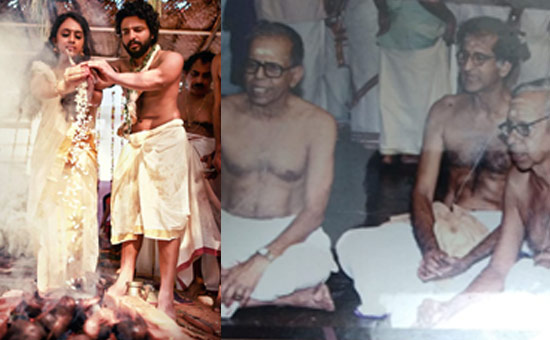
17. Fire circumambulation,
Agnipradakshinam - Couple does fire
circumambulation reciting special mantras. The mantra affirms that by this
marriage, we have entered into an inseparable relationship like that between
Rigveda and Samaveda or that between the elements of sky and earth.
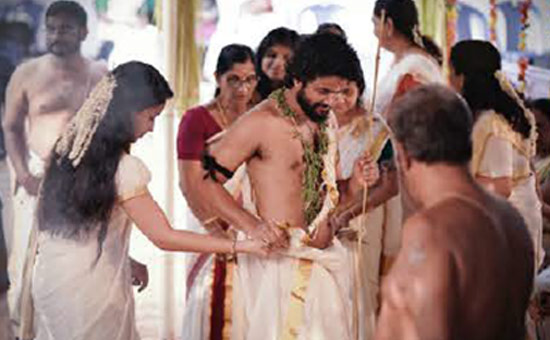
18. Stepping on
rock, Ashmarohanam - Reciting
mantras, groom makes the bride step on a piece of rock. By the mantras, the
couple prays for rock-like hardness and stability to face all issues in life. This
rock is the Ammi or grinding stone
that was traditionally used in homes to grind pastes. Hence, this ritual is
also called as ammi chavattikkal or
stepping on the ammi.
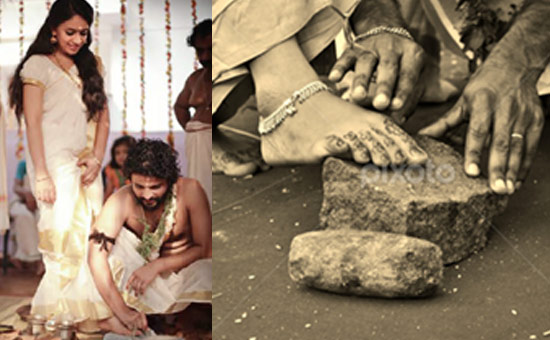
19. Ritual of
seven steps, Saptapadhi - The couple takes seven steps together reciting
mantras seeking wealth, prosperity, energy and many kids of good health and
habits.
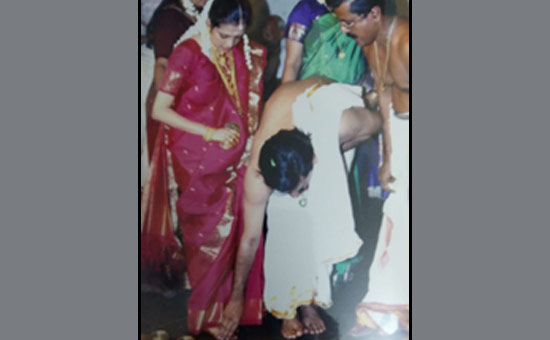
Note that steps 17, 18 and 19 in sequence are performed three times. In 2nd and 3rd
sequence, Gods of marriage for Laja homa, are Varuna and Pusha respectively.
Remaining puffed rice is offered to Prajapati.
20. Joining of
heads - Bending backwards, the couple touches their heads together. The
main Prana or breath force is located at Brahma
Randhra, at the centre of the top of the head and this ritual denotes union of the couple’s life forces.
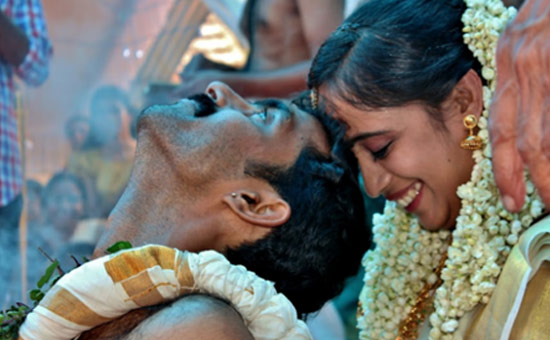
21. Arundhati sighting
- Couple now prays for blessings and good life turning towards the north where
the star Arundhati, the symbol of good married life, Dhruva, symbol of steadfastness and the seven sages are located.
The bride recites mantras seeking blessings for good children and avoiding
widowhood.
22. Conclusion
of fire ritual, homa, marking the end of the main marriage ritual. At the end, as a part of this ritual, the groom ritually transfers the God of Agni, present in the fire where the ritual is performed onto a stick of ‘Samidha’, a special tree. This is where the fire of ‘Garhapatyam’ resides for the couple to use in all the fire rituals (homas) to be performed by them in future.
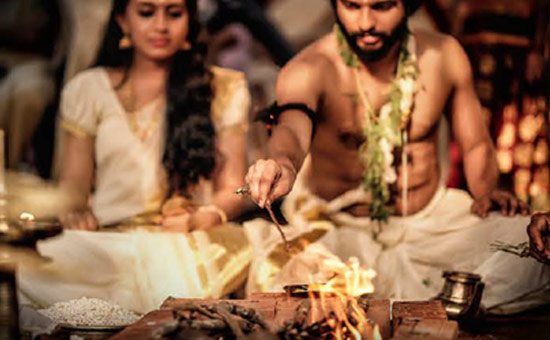
It is believed that the couples wedded
as per Vedic ritual become inseparable and divorce is absolutely irrelevant.
Death of a partner or the husband entering Sanyasa,
with full agreement of the wife are the only cases of separation after Vedic
marriage.
The author expresses
gratitude to Shri. K M Vasudevan Namboodiri for his inputs.
Author is a retired Chemical Engineer with forty years’ experience in large chemical manufacturing companies and process control applications. Currently working as a volunteer with Samskrita Bharati and has been teaching Sanskrit in weekend classes for about 10 years.
References
1. Write up on “Importance of Marriage rituals” and “Marriage of Kerala Brahmins” in Malayalam by KM Vasudevan Namboodiri.
2. “Pakazhhium Chatangu”, reference book for rituals.
3. Site www.namboothiri.com
Photos courtesy Shalini P. They are from weddings of Deepthi with
Neeraj Madhav and Divya with
Hrishikesh Kadampatta. Pictures taken from links below.
1 https://www.youtube.com/watch?v=G1XWspzXmho
2 https://www.pixoto.com/images-photography/wedding/ceremony/flexibility-in-family-life--4917000877899776
3 https://www.pixoto.com/images-photography/wedding/ceremony/hard-as-the-rock-5107847581925376;
4 https://www.youtube.com/watch?v=hLdpp2pQt6c;
5 https://www.youtube.com/watch?v=LK2zknywzdI;